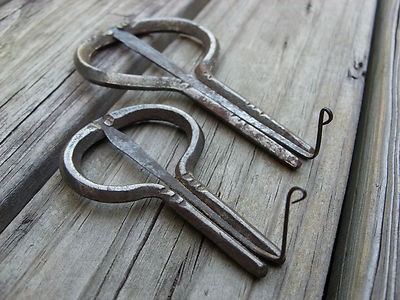Music To Our Ears Mouths: A Jaw Harp Found in Fredericksburg
By: Kerry Gonzalez
This month’s blog will continue our series on Dovetail’s recent excavations at the Riverfront Park in Fredericksburg, Virginia where over 10,000 artifacts were recovered. Many of these artifacts were personal items, one of which is the focus of this blog. Recovered from an area where a late-eighteenth-century brick duplex once stood at the corner of Hanover and Sophia Streets, this jaw harp speaks to the leisurely activities that took place at the site during the early-nineteenth century.
The iron alloy jaw harp, or “Jew’s harp” as they are often referred to, was identified after a series of x-ray images were taken on over 1,500 metal artifacts recovered during the project (Photo 1). X-ray is often used by archaeologists to help identify severely corroded pieces recovered during a dig. Prior to the x-ray, the team was unable to decipher the use of this iron object.
This type of musical instrument is a fairly common find on archaeological sites, with the earliest discovery from Inner Mongolia dating to the eighth and fifth centuries B.C. (Elizabeth Morgan 2008). A 1,700-year-old jaw harp was also recovered from the Altai Mountains in Russia (National Geographic 2018). The Russian mouth harp had a distinctive three-tined shape unlike the more ubiquitous bow-shaped jaw harps seen today (Photo 2). While the shape of the jaw harp may have changed, the manner in which it was played varied little.
By placing the frame against their front teeth and flicking the spring, players can create a distinctive twanging sound. Different notes can be played by altering the shape of the player’s mouth. (Mackinac State Historic Parks 2018).
In a thesis published on this very topic, Deirdre Anne Elizabeth Morgan (2008) asserts that the mouth harp plays an important and interesting role in courtship and procreation especially in southeastern Asia. It is suggested that the shape of the mouth-played instrument has symbology related to procreation and it may “possess an innately erotic character” (Bakx 1998). It is further suggested that because this instrument is solely played with the mouth it provides a focal point for suitors trying to lure a mate through both their mouth and their musical prowess (Elizabeth Morgan 2008).
Finding musical instruments on sites helps archaeologists understand the vernacular lifestyle of occupants and illustrates how music often helped provide a mental break from their day-to-day activities and create a comforting sense of place.
References:
Bakx, Phons
1998 The Jew’s harp and the Hindu God Shiva: Into the Symbolism of Procreation. The Thoughts’ Dispeller Booklet Series 1. Stichting/Foundation Antropodium, Middleburg.
Elizabeth Morgan, Deirdre Anne
2006 Organs and Bodies: The Jew’s Harp and the Anthropology of Musical Instruments. Electronic document, https://facultystaff.richmond.edu/~amcgraw/gamelan/ubc_
2008_fall_morgan_deirdre-libre.pdf, accessed March 2019.
Mackinac State Historic Parks
2018 Jaw Harps. Electronic document, https://www.mackinacparks.com/jaw-harps/, accessed March 2019.
National Geographic
2018 1,700-Year-Old Musical Instrument Found, and It Still Works. Electronic document, https://news.nationalgeographic.com/2018/01/ancient-musical-instrum
ent-mouth-jaw-harp-siberia-russia-spd/, accessed March 2019.
Any distributions of blog content, including text or images, should reference this blog in full citation. Data contained herein is the property of Dovetail Cultural Resource Group and its affiliates.


